#like ruffs and farthingales
Text
doing reading on 17th century clothes is a lot of. men really fucking hated the way women dressed.
#they always have lmfao#its honestly because most sources about the fashions#are from critiques or satires of them#and not a lot of perspectives from the women themselves unfortunately#as well as a lack of extant garments#SO most of our info is men who are mad about it#jordan talks#all three of these articles ive read have been about how people moralized about stuff#like ruffs and farthingales#time travel would be so useful for asking people who didnt/couldnt write their thoughts down#what they thought about things
6 notes
·
View notes
Text
Some random fashion/hairstyle/accessory headcanons for asoiaf. total and complete mashup of historical periods of the middle ages
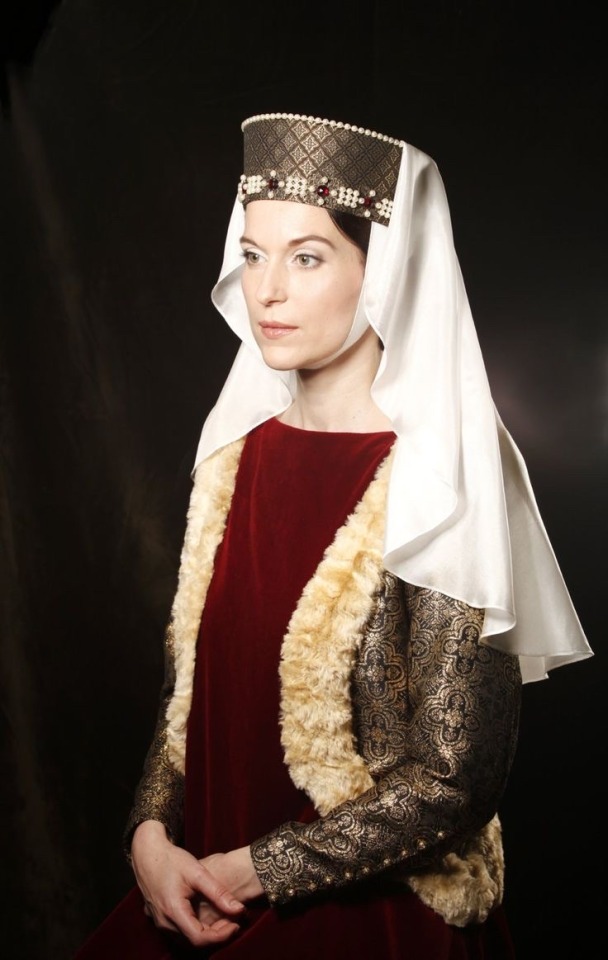
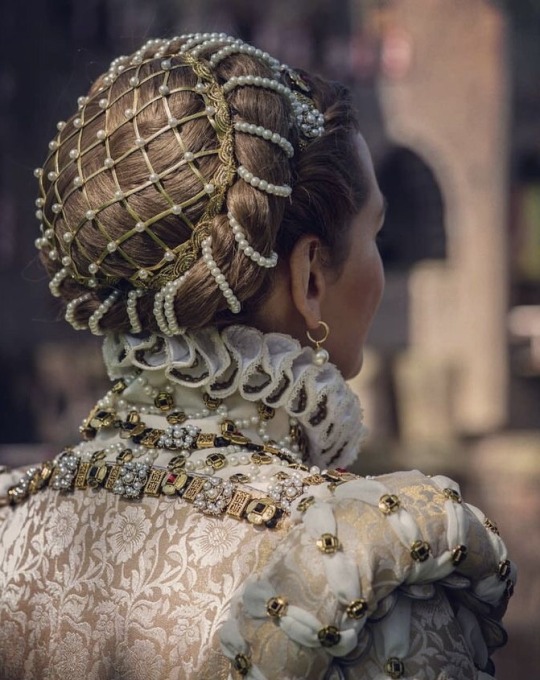
I think women in the Stormlands are all about those wimples, snoods, cauls, etc cause you know, wind and all that. I think the higher up the chain of nobility a woman gets, the less she covers her hair up - it shows a pretty high level of wealth and privilege to have the time to sit for hours while a servant pins hair up in an elaborate style made to hold in the wind. As well as the privilege noble ladies have of being able to just go inside when the weather is stormy, as opposed to smallfolk who potentially don’t have that option when they’re running farms and shops (and therefore need something to hold their hair with little effort 24/7)


I think the Riverlands are pretty similar to the Stormlands in that they are generally a more practical sort of people, and wealth is displayed more through impractical items to wear and/or make. Fuckoff big and weird headgear, ruffs that take a lot of time and fabric to make, farthingales (even if that is pushing it on the “middle ages” time period) and especially French farthingales on special occasions


Westerlands on the other hand? It’s precious metals, jewelry, gemstones embroidered into clothing, gold braid, velvet, fur, every ostentatious display of wealth you can think of. I also like them wearing farthingales, since they’re right next to the Riverlands and I like them in similar but slightly different styles (for reasons that will go in another post). In general I also like the idea that clothing gets less structured as one gets further south, so the Riverlands and Westerlands are the only ones wearing farthingales
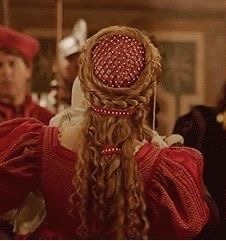
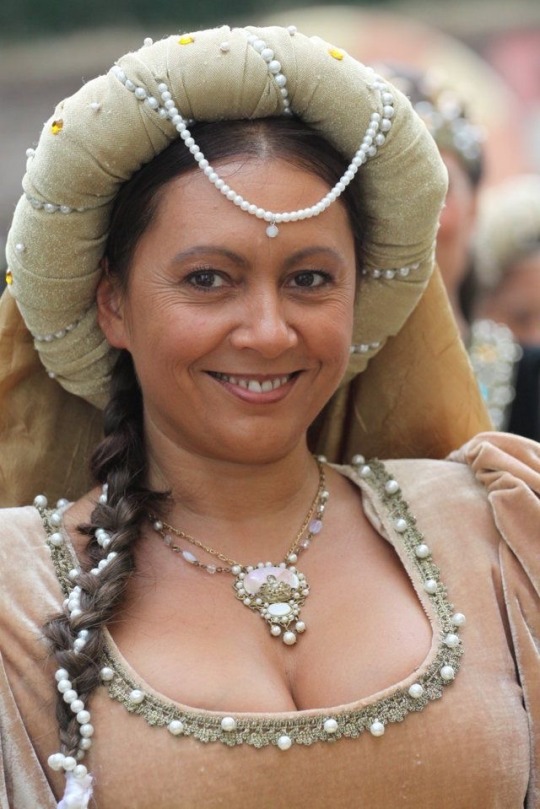
The Reach is a very romantic culture, so I think the women there would want to show off their hair while still staying within the realm of Westerosi modesty. Unmarried women wear their hair “down” but still held back with braids in some way, while unmarried women wear something close to a balzo so they can show their hair while still keeping it “covered”. The Reach is a pretty big region, so as you get closer to the Riverlands you start to see some escoffions, as you get closer to the Stormlands you start to see more elaborate braids and cauls, etc.


So we been knew that Iron Islanders are Vikings but I do actually love Viking clothing for them specifically because of the little brooches/pins/patches they wear to hold the straps on their strap dresses. Vikings historically would have used these to attach and carry various items, and it does feel very Iron Islands for their few bits of decoration to also serve a practical purpose.
#a song of ice and fire#asoiaf#asoiaf hair and clothing#asoiaf headcanons#iron islands#the reach#westerlands#riverlands#stormlands
69 notes
·
View notes
Note
Piggybacking off of your costumes comment: I loved a lot of them, but I wish there was a bit more of a cohesive silhouette. Especially so you could tell the passage of time a bit easier. ALMOST every era in history has a cohesive silhouette. Like the 1860s are known for the slim waists and the big circle crinolines, the 1520s known for the big sleeves and the head coverings (among other things)
It’s fantasy but there should be some cohesion.
Yeah that's my big thing, there should definitely be some sort of link in the costumes rather than everything just seeming very much like they all got dumped out of a bin and rifled through. It's one of the things that earlier seasons of GOT actually did fairly well, the fashion of King's Landing was defined with a specific kind of hairstyle and those wrap kimono style gowns with long hanging sleeves, men in the cities of Slaver's Bay wore those specific robes with knotted cloths that differed in types of colorings for the different cities specifically (white and green in Astapor, white and blue in Yunkai, blue and yellow in Meereen). Not only was there cohesion in the silhouettes overall, but there was also cohesion based on location, and key differences based on location as well, the same way that the silhouettes for fashion in our world have varied based on location and culture (the silhouettes of the Mughals during the reigns of Shah Jahan and Aurangzeb looked very different to the silhouettes of the English in that time period, for example). Alicent and Otto are from Oldtown, which is actually pretty far removed from King's Landing, it's further south and on the Western end of the continent where King's Landing is on the east, so why not see some differences in the clothing that they tend to gravitate towards vs the kind that people who've lived in the Crownlands might wear. The Targaryens are also still clearly trying to keep in touch with their Valyrian roots at this point, what with all The Tapestries and everything, so why not have their own sense of fashion have a flair of Valyrian to it, to mark them as distinct even beyond the pale hair whenever they walk into a room, rather than just a simple red color scheme. Another issue for me was also just that the clothes never seem to convey passage of time? HOTD season 1 alone is meant to take place over a period of twenty years, and even in twenty years silhouettes change a lot. The costume designer I think said they were modeling a lot of the clothing on the Renaissance for instance, which is why we see a lot of men with chains of office on fancy occasions, and the silhouettes of the Renaissance also went through changes. For example, the 1550s tends to hew closely to the fashions we expect from Tudor dramas, wide and triangular skirts and hoods and hanging sleeves, whereas the 1570s was seeing the emergence of the types of fashions you think of when you think of Elizabeth I or Mary Queen of Scots, the beginnings of farthingales and puffed sleeves that were close fitted at the wrist and a lot of ruffs. It would have been cool to see how Rhaenyra and Alicent and Daemon's fashion choices all evolved not just due to personal decisions, but also to the simple passage of time and the change in styles that would come with it even if the changes are only slight, and it would have helped with the overall timeline better.
Yeah, there are costumes that I do think look good, and barring some nerdiness about why certain people aren't wearing chemises or other stuff (I know it's not real but like why isn't Alicent wearing anything under the green dress if she's just got straight brocade damask on her skin that's just gonna be uncomfortable, that's why people liked chemises back in the day!), but I do wish they looked more put together than they do.
#personal#answered#anonymous#yeah the lack of cohesion was also a huge thing for me too#tho sorry that i went all nerdy on y'all with this response
10 notes
·
View notes
Text
Last night I started reading Lords and Ladies, and my dress history obsessed self is having a rather difficult time with this part:

(Sorry for the poorly chosen colors)
1. What item are they talking about??? Shouldn't it be easy to tell which way is up? (Though I've seen people make this mistake with corsetry for multiple eras)
2. Okay, I see why a citizen of Lancre wouldn't know, but (see 9) and what kind?
3. Why in the world would Verence order a garmet of that type that was designed by Ikea? There's a reason why it took skilled needleworkers to make that stuff.
4. Why the heck not? Well, ok, court panniers would be one thing but pocket hoops? She would be able to carry so many pieces of occult jewelry in pockets hidden underneath the panniers! [Those pockets could be magic all on their own, witch or no] (see meme at 8 and see 9)
5+6. So Sto Helit considers the ruff fashionable, but what kind? And when? Were they fashionable elsewhere?
7. Is it brocade or something else? If it is brocade why is it so stiff?
8. Why turn down the carrying capacity of pockets? (You will not convince me that the witches wouldn't appreciate the practicality)

9. Why does she need a farthingale and panniers? They'd have to be for different outfits, but here it sounds like the plan was for her to wear both at once??? Or it it just me?
I'm ignoring that different items are from different Roundworld eras because Discworld seems to be more than a bit mix-n-match on that front. And because of that I really wonder what makes a good or bad costume in the Ankh-Morpork Historical Re-creation Society [aka the Peeled Nuts] and I wonder if court fashion tends to lag on the Discworld like on the Roundworld.

Seriously, I'm thinking far too much about this...
#discworld#gnu terry pratchett#meme#discworld meme#thought(s) from yours truly#disc fashion#dress history#dress history meme#created by yours truly#lords and ladies#magrat garlick#magrat#why am i like this#sto helit fashion#lancre fashion#lancre witches#lancre coven
11 notes
·
View notes
Text
Hororr-documentary about Tudor fashion
I am usually trying to give people benefit of doubt regarding inaccuracies in their work. We are all humans after all. But everybody has their limit and when you publish a documentary I expect it to be accurate with minimum mistakes.
So on youtube there is video called TUDOR FASHION (2023) - FULL DOCUMENTARY - HD.
And it is absolutely inaccurate. The mistakes, the misconceptions, misleading myths presented as facts! On scale of 0-10, I’d give it -5. Long story short-don’t watch it, it’s total waste of your time!
But if you’re interested in my shorter rant about how inncaurate it is, allow me to entertain you a bit with some of their best bits!
-In Tudor times english poor people wore mostly clothes made of cotton!
(They meant wool.)
-Tudor sumptuary laws forbidden everybody but royalty to wear crimson!
(High nobility could wear crimson throughout entire Tudor era!)
Apparently corset and stays were worn simultanously during Tudor era.
(Stays were predecesor of corsets and even during Elizabethean times, women wore their stays, not their corsets!)
Aparently Tudor nobility bathed a lot! (First time I hear of that!)
Aparently Anne Boleyn NEVER wore english fashion(I am sorry what about the medal? What about lady of the garter depiction? Doesn’t ring a bell?)
and she introduced french hood and french gown to English court
(this is myth. Mary Rose introduced french hood in mid 1510s and french gowns gained on popularity after Field of Gold in 1520.)
Oh did you hear Catherine of Aragon was forced to give up her spanish clothes especially her fartingale upon arrival to Englan?-probably in Marie Antoanette style(i mean the movie).
(That's lie. She did adopt english ways and clothes as was espected, but it was gradual change. Not something she’d be forced to do immediately upon arrival as was implied. Also, you have to distinguish between farthingale and early fartingale which was called verdugado and didn’t have the conical shape they mention. So they don’t know basics about fartingale!)
Other interesting ‘facts’:
Tudor early fashion didn’t exist! Because they didn’t include it!
Nice that we hear english hood was also called gable hood, but how about informing us of its historical name-frontlets and bonnet which would prove you know it isn’t actually a hood?
Apparently throughout entire Tudor era you could randomly decide to put on ruff or farthingale. Because nobody included date of when these came to fashion!
Oh and Henry only had only 3 wives, because they skipped Anne of Cleves, Catherine Howard and Catherine Parr! Like WTF.
Henry VIII started to dress up with new materials and dyed clothes available to him only through naval discoveries!
(I was always under impression that silk and cloths dyed in Asia arrived to Europe much earlier. Technically this is not entirely impossible scenario, but as far as I know, all materials and dyes available to him were already available to his parents.)
Apparently Henry VIII only passed one sumptuary law in 1540s(i was always under impresion he passed several...)
and he introduces those laws-he was first to ever make them(lie as hell!)
He also stopped wearing longer coats solely to show off his legs
(apparently that male fashion all around europe went with shorter coats was mere conincidence not worthy of mention.)
Also the inaccurate depictions or portraits used are staggering. For first few minutes while they talk about Tudor dynasty they show portraits of royalty from 16th century(and few from 17th century) of which majority is not even english.
For Jane Seymour when they first talk about her they don’t use her portrait by Holbein, but sketch of unknown woman in gable hood, which is commonly assumed to be Anne Boleyn.
When we finally see portrait of Jane it is not in very good quality.
And this documentary at beginning said majority of information we got about Tudor fashion is from portraits-but fail to show even well known portraits in good quality.(in 2023!)
For Anne Boleyn they use portrait of Anne of Bohemia and Hungary, which was in past mistakenly labelled as Anne Boleyn(because of label Anna Regina), but by now it well-known in Tudor circles that it is not her and the outfit is central european!
Oh again ‘the divine timing’ thing about Anne’s miscarriage coninciding with Catheirne of Aragon’s funeral. Overall this documentary has tons of ‘facts’ and information regarding general tudor history. Things we heard milion times before which have absolutely nothing to do with Tudor fashion!
If we left this out, the documentary would be half an hour instead of hour. It takes really a lot of time, and I don’t think documentary focused on fashion should do this.
They also lie about Jane’s waistline being slightly under normal. I’ve seen her portraits and many other portraits, only thing abnormal about her waistline is the gap which reveals more forepart than is usual. Rest must be her bodyshape.
Also they totally flip how Jane Seymour thought about french hoods at least at first. Initially they say ‘ Jane was forced to give up french hood’ Instead of Jane was FORCING others to give up french hood! (she’d not allow women to serve her in it. She had problems with it, nobody else!’
‘and told to obtain frontlets and bonnet instead’(by this time they didn’t explain this is what gable hood was called, so viewer who doesn’t know it before watching this, doesn’t have a clue what they mean.)
Only then they say she banned it! Their editing sucks!
Also the lie about Jane bringing english hood back! It didn’t disappear by this time, it just started to lose on popularity! It’s misleading as hell.
And for Jane the ‘1526/1527 miniature was used! (You know the miniature nobody knows who it is, but was at times labelled as all different women Henry VIII has ever slept with.)
They use horrible photos of Mary’s portraits! Some prior to restoration-and I recall these portraits only ever restored. So very old photos.
I’d not call Mary’s childhood idilic. I’d say it nicer than her later life, but it goes hand in hand with lie/myth that marriage of her parents was happy for 20 years. When it was broken/cold before she was born. So it is misleading in way.
Then one drawing which I believe is of Isabella and drawings not based upon Mary’s actual portraits showing inaccurate shape of fartingale more typical for gown worn by her relatives elsewhere in Europe.
Or drawing showing gowns from 1560s or 1570s, which more likely show Mary Stuart. In past portraits of Mary I of England and Mary I of Scotland were confused a lot. But by now, you should not not confuse them. The fashion differences are pretty obvious and person learned in Tudor portraiture in 2023 should absolutely not make this sort of mistakes.
It’s also inccurate to say by Mary’s reign french hood was on its way out. Because what happened was that french hood’s shape changed to be more square, but it was still french hood, just new type.
It’s not ok to call verdugado fartingale and then don’t call Mary’s headwear french hood. It shows you either have double standards or you do not know what you’re talking about.
Later style of French hood kept being worn even in Elizabethean times, but due to different hairstyles and angle it is not very visible. By stating that Mary already didn’t wear it( or as they said later- that it was final stage of french hood-once again horrible editing), you’re misleading people greatly.
‘Mary dressed in utterly english style at beginning of her reign and later started to dress in more spanish manner, added spanish elements to her clothes and wore clothes in darker colours etc’
(Didn’t you say little while before her favourite colour of gown as Queen was crimson? Like make up your mind and show me proof she wore way more of spanish fashion. Like a drawing or portrait which is not madeup.)
They mistake Mary I’s pearl and la Peregrina pearl.(I’ll allow that, because not long ago even I wasn’t aware those were two different pear-shaped pearls.)
Instead of using photo of portrait of Elizabeth as Princess, they use a drawing of it. And i don’t have a clue why. It’s freely available!
I stopped watching at 40:00, because honestly I didn’t want to continue. It was boring as hell.
But overall it is very inaccurate and misleading ‘documentary’. Substandard on many levels, showing very little of true facts, very few of them presented in non-misleading way and very little actual information about Tudor fashion.
It’s total waste of time. Don’t watch it.
3 notes
·
View notes
Text
Witcher Fandom: Costume Historian Weighing In- the prologue
hello all i was starting a post on historically accurate Witcher fashion and i really have to watch the show again to see if i can trace a more narrow time period to the clothes OR thematically narrow it (i.e. Witchers are more Polish Medieval while Mages are more Italian Renaissance)
Originally, I’d roughly placed the time period as Tudor-to-Baroque/Cavalier [1500-1650] due to:
Inclusion of waisted doublets/jerkins/men’s gowns
slashed/paned clothing
”grown on” collars for men and women
skirts (roughly) more shaped like a farthingale than with panniers
so here’s just a list of things throwing the illusion of time period accuracy off:
NO RUFFS or Piccadills (trust me they’re very cute lace collars) though we do get peeks of small ruffled collars
80% of the women- it’s all over the place in my recollection. They look good but Calanthe and Yennefer are definitely rocking more couture looks
very few hats: yo these bad boys really help you nail a time period down and they’re just kind of absent which is fine I love everyone’s hair
THEY HAVE PANTS- proto-pants/trousers dip in and out of existence but sorry my dudes full length, one piece/both legs, trousers just did not exist then. Pants as we know them are such a new phenomena.
Piggy backing off that- the doublets really do slip between Henrician (early Tudor- slim waisted with paned/slashed sleeves and peplums) and Cavalier (looser fits with/out a waist and wider cuffed sleeves). Like I’d place Mousesack/Ermion as having an Henrician men’s gown, Jaskier’s Four Marks and Rare Species appearance as having a more Elizabethan look (smaller shoulder puffs or wings, longer slashes across the breast), and Geralt’s jacket in Of Banquets, Bastards and Burials as being more loose/Cavalier in cut
I’m not really sure what my goal is here, but I’d like to put out a few resources for folx to look at for inspiration so heads up follow the tag “Witcher Fandom: Costume Historian Weighing In“ if you’d like to see these posts
3 notes
·
View notes
Text
Okay obligatory disclaimer that I do not think anything is inherently masculine or feminine and that society's idea of that is VERY fluid but it's useful when discussing fashions especially in the past to categorize things as masculine and feminine so keep that in mind as we proceed
Something I find interesting and is just really an example of the varying differences in human tastes and preferences is that as much as I enjoy various different eras of masculine fashions just like I do feminine ones it is much easier to dull it down into a cohesive style I would choose to come back into fashion despite enjoying things VERY different to but with feminine styles I would definitely be able to give you elements of what my most enjoyed features are (puffy sleeves in any variety, dramatic skirts in any variety, fun hair of any style) I couldn't point really mesh it all together into just one style. I think that could definitely be because women didn't have as much they were allowed to participate in so fashion changed so much more and so frequently that big sleeves could refer to giant farthingale sleeves of the late elizabethan era or 17th and 18th century sleeves with large cuffs or the more contained sleeve puffs of the 1830s or the 1890s and that's not even getting into the vast options for skirt shapes and skirt supports from the early 16th century into the 20th. That is a lot of ramble from what originally was me wanting to show off the specific things I would like to see people embrace in future because I love them so let me get back to that:
First I have to put a note for one of my favorite styles that I don't know if I'd particularly recommend as the next hot fashion trend especially with modern tastes and needs in mind but I cannot talk about masculine styles I love without bringing up the delightfully silly early 17th century
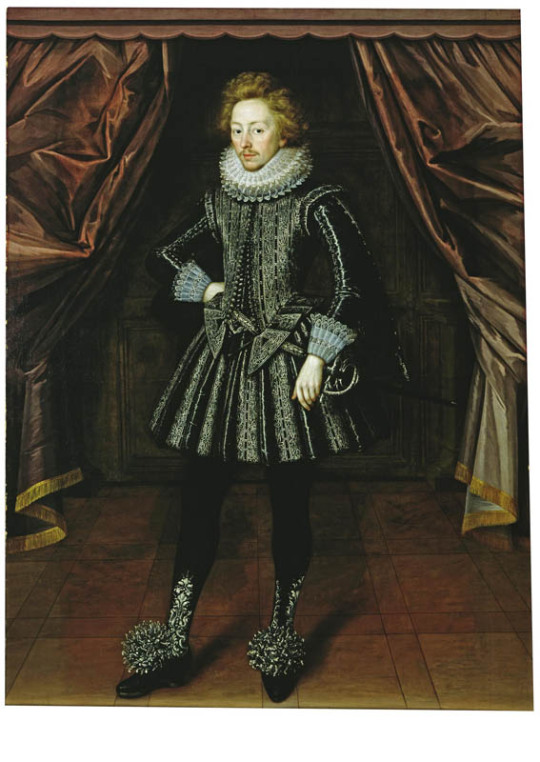
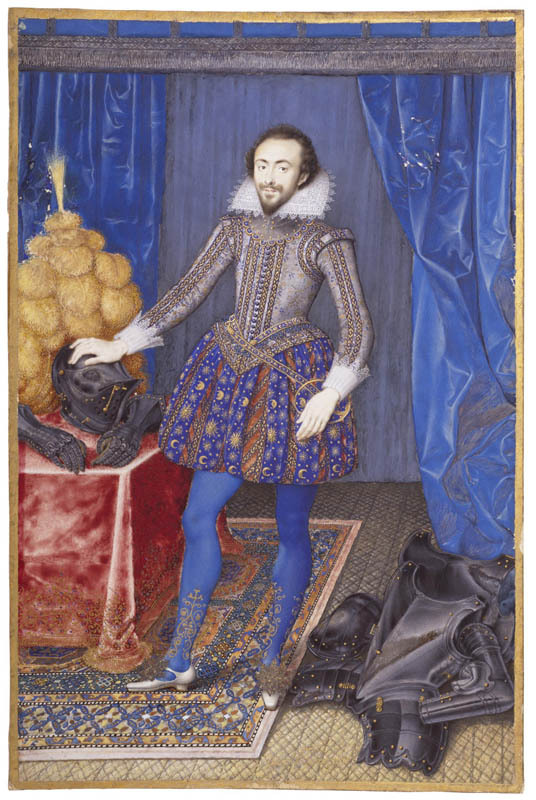
Could NOT tell you why but styles like these are very endearing to me
What I WOULD recommend as the next hot fashion trend is a mix of styles from about the 1790s to the early 1850s so roughly what you might call the romantic era but would be broken up into about three categories in fashion history circles but I digress



First of all I have to emphasize how important knee length breeches with stockings are to this. If you skip this the entire vibe is off. Yes I am sad trends moved away from breeches and into pantaloons why do you ask
The next VERY important piece of this puzzle is a fun patterned waistcoat!


A plain waistcoat is absolutely NOT acceptable
Brief cravat interlude (even though I cannot waste on of my ten images solely on that) because if I cannot have ruffs I would like a nice cravat
And the final lovely piece


Which is of course the coat <3 particularly the style you see in the 1820s to 30s with the lovely gathered puffed sleeves and the large skirts with that little nipped in waist just absolutely chef's kiss completely iconic
And that my dear friends is my ideal for a hopefully at least somewhat lasting hot new fashion trend <3 I know it will never happen but I can dream
0 notes
Text
Imagine being a sexy bitch in the Elizabethan era... the endless religious killing sprees having finally stopped and now life is a constant party. Titties popping, farthingale out to there, ruff starched within an inch of its life; your chief hobbies are dancing until you wear through your custom strawberry-embroidered slippers and scarfing down sweetmeats (though you might never figure out what those actually are). Everybody kins someone from Greco-Roman mythology, but the Queen banishes her doubles from court; half a dozen dandies with curled hair and pearl earrings write you sonnets about how your boobs are like fat white ducks, and then, when you ignore them, how your icy cruelty will drive them to a tragic and sexy grave. The art and music scene is insane; Hilliard paints your best glove into the background of your new boy toy’s portrait miniature to immortalize you going steady. Living fast, dying young from sweating sickness or all that fucking lead paint... dream
20 notes
·
View notes
Link
A Discovery of Witches drops first season 2 photo, with Matthew Goode in a doublet
By Maureen Lee Lenker Sept 5, 2019
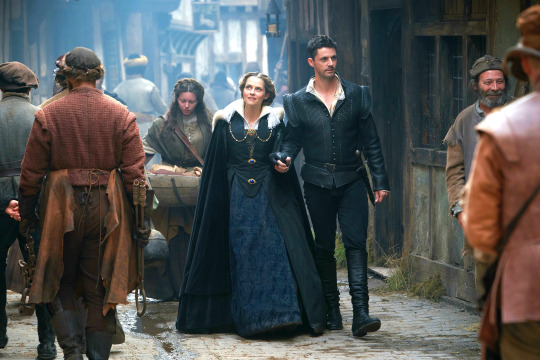
My edits. Origianal photo: Sky One [Rosalyn51 note: This is the highest resolution pic of the day so far 2700x1800 pixels x]
The past is about to get witchy.
A Discovery of Witches released the first official photo from its upcoming second season Thursday, featuring witch Diana (Teresa Palmer) and vampire Matthew De Clermont (Matthew Goode) in full Elizabethan garb.
Keen fans of Deborah Harkness’ source novels will recognize the setting as Blackfriars, where Matthew and Diana make their home when they travel back to Elizabethan London to escape the Congregation and unlock the secrets of Ashmole 782, also known as the Book of Life. The photograph showcases Diana in traditional Elizabethan dress, including a full skirt with a farthingale underneath and a high starched collar, a more casual version of a ruff. Matthew walks beside her holding her hand, wearing a leather doublet and matching breeches.
“We’ve finally arrived at Elizabethan London… Who’s excited for season 2?” the show’s Twitter account asked alongside the release of the image.

The first look also comes with some long-awaited casting news, including the actors who will bring to life the fan favorite Gallowglass, Matthew’s Norse-Gaelic vampire nephew, and Phillipe De Clermont, Matthew’s stepfather. Steven Cree, who portrays Jamie Fraser’s beloved brother-in-law Ian Murray on Outlander, will portray Gallowglass, a hunky vampire and soldier of fortune who holds a soft spot for his uncle. British actor James Purefoy, best known for his work on Rome, will play Phillipe, founder of the Congregation, commander of the Knights of Lazarus, and mate of Ysabeau.


“To have such high caliber talent joining an already exceptional ensemble is a testament to Deborah Harkness’ brilliant novels, Pete McTighe and Susie Conklin’s scripts, and to the immensely talented cast and crew working to bring all to life,” executive producer Jane Tranter said in a statement. “The bar was set high with season 1, but season 2 is already shaping up to take fans into a new realm as we follow Diana and Matthew into Elizabethan England. With cast like this they will not be disappointed.”
Much of the rest of the season 2 cast was announced as well, including Paul Rhys (Victoria) as the frightening vampire Andrew Hubbard, Sheila Hancock (Doctor Who) as the witch Goody Alsop, Barbara Marten (Casualty) as Queen Elizabeth, Jacob Ifan (Cuffs) as Benjamin Fuchs, Holly Aird (Waking the Dead) as Francoise, Michael Lindall (Deep State) as Sir Walter Raleigh, Adam Sklar (Faceless) as Henry Percy, Joshua Pickering as Jack Blackfriars, Elaine Cassidy (Harper’s Island) as Louise De Clermont, Victoria Yeates (Call the Midwife) as Elizabeth Jackson, Adrian Rawlins (Chernobyl) as William Cecil, Lois Chimimba (Doctor Who) as Catherine Streeter, Amy McAllister (Philomena) as Marjorie Cooper, and Milo Twomey (Mother, Father, Son) as Pierre.
Season 2 will also see the return of much of the season 1 cast. As Matthew and Diana face new dangers and mysteries hidden in time, the story in the present day will also continue as Diana’s aunts, Sarah (Alex Kingston) and Em (Valarie Pettiford), take shelter with Matthew’s mother, Ysabeau De Clermont (Lindsay Duncan), at her home in France, Sept-Tours. In Oxford, Matthew’s trusted allies Marcus (Edward Bluemel) and Miriam (Aiysha Hart) will strive to protect daemons Nathaniel (Daniel Ezra) and Sophie (Aisling Loftus). The Congregation, including Gerbert (Trevor Eve), Peter Knox (Owen Teale), Satu (Malin Buska), and Domenico (Gregg Chillin), will also enlist their considerable powers to hunt down Diana and Matthew and the secrets they’re keeping.
Season 2 will be based on Harkness’s second novel in her All Souls Trilogy, Shadow of Night. No premiere date, either in the U.K. or Stateside, has been announced.
*Meanwhile Radio Times reported “The second series of A Discovery of Witches is currently filming ahead of a confirmed early 2020 airdate" 🙌🙌
#matthew goode#matthew roydon#matthew clairmont#a discovery of witches#teresa palmer#james purefoy#steven cree
87 notes
·
View notes
Text
ALRIGHT I’VE BEEN ABSENT THREE MONTHS, LET’S TALK AZIRAPHALE AND RENAISSANCE FASHION!!
now, we know aziraphale tends to be a bit old-fashioned, so let’s be real with ourselves here, by the third and final phase of the renaissance (1550-1600) he’s still firmly stuck in 2nd phase fashion. we’re talking the duck bill shoes, puffy shirts gathered at the neckline with some absolutely INTENSE embroidery (spanish work that he did himself with great enthusiasm and that looks truly hideous, but that is so impressively...everywhere that you just have to compliment him out of sheer intimidation), slash & puff sleeves that look like a cat got trapped in his garment bag and went to town, and so many panes (looooong loops of ribbon, see the “pants” he’s wearing in the series episode) that he just gets trapped on everything around him.
did i mention this is around when lace becomes a thing? aziraphale wears so much lace. so. much. fucking. lace. no wonder he almost gets guillotined in france later on, he constantly dresses like he owns several castles.
but there are a few things that the third phase comes up with that he absolutely adores and adopts in a heartbeat. like shirt ruffles and the infamous shakespeare ruff, once again as seen in the episode. and when the ladies come up with the ruffs that open up to showcase both the square neckline AND show off some tiddy, he’s all in from the first debut.
his more feminine looks are SOLIDLY set in the third phase of the renaissance, all wheel farthingales --- skirts like tables, y’all, i can’t make this shit up, or how fucking much aziraphale loves it --- and french pushed-back hoods, and the ferrionierre, the fancy ones with the little pearls beaded all across them. it’s SUCH a look. it’s as glamorous and wide and puffy as all get out, and aziraphale absolutely works it. fans? HUGE feathers, rarely more than three but always the biggest and most lavish things you’ve ever seen, either ostrich or peacock feathers EXCLUSIVELY because he likes the way they go with his fairly banal cream-and-white angelic color schemes.
overall, aziraphale is VERY much still an assimilator, for all his little flourishes of personal style. he’s a little like booth from bones in that he has tiny little symbols of rebellion while remaining within the confines of his job requirements, like a slightly longer-than-acceptable hairstyle in renaissance times and the fancy fans that really do not help him blend in as heaven would want him to. he has the fashion mole before just about anyone else in the world, blends typically feminine and masculine fashions into a very unique style that he’s absolutely thrilled to see humans begin to develop for themselves later on; fashion is where aziraphale expresses his individuality, where he can get away with little quirks and rebellions, and it shows, baybee.
#( ooc. ) DOLPHINS!#( headcanons. ) DOESN'T MEAN YOU HAVE TO BE A FOOL.#this is literally just an excuse for me to share with y'all my new favorite fashion era#but also aziraphale and fashion? a match made in heaven. he lives for innovation#and lace. specifically lace. and embroidery. the overuse is dangerous and blinding
4 notes
·
View notes
Photo
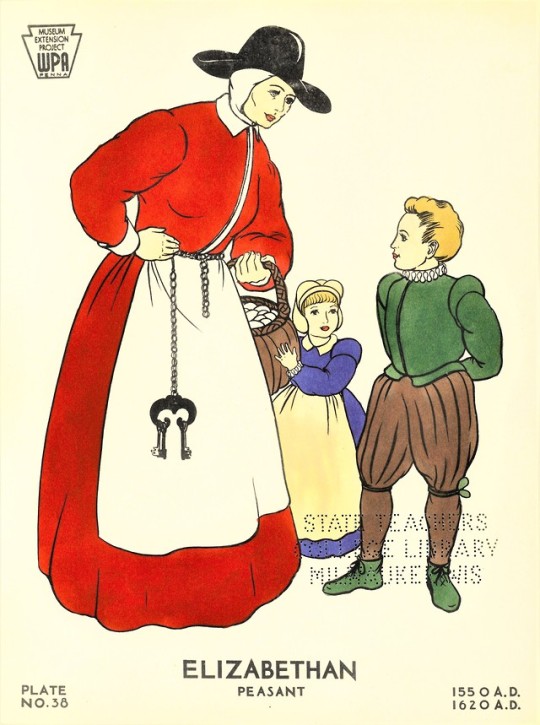
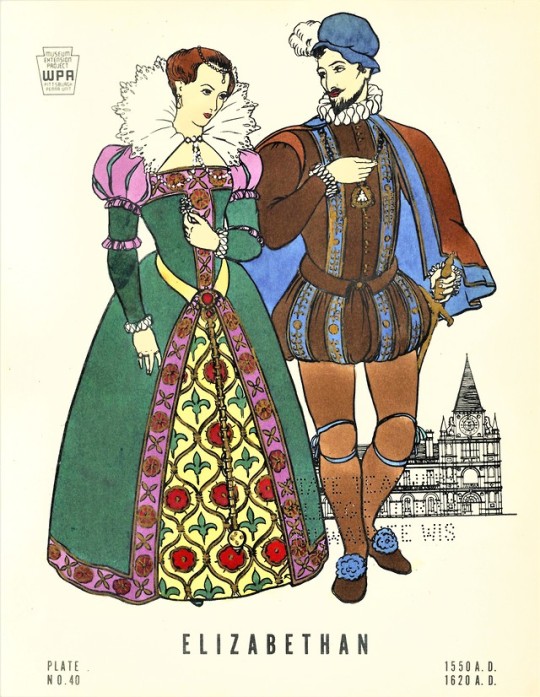
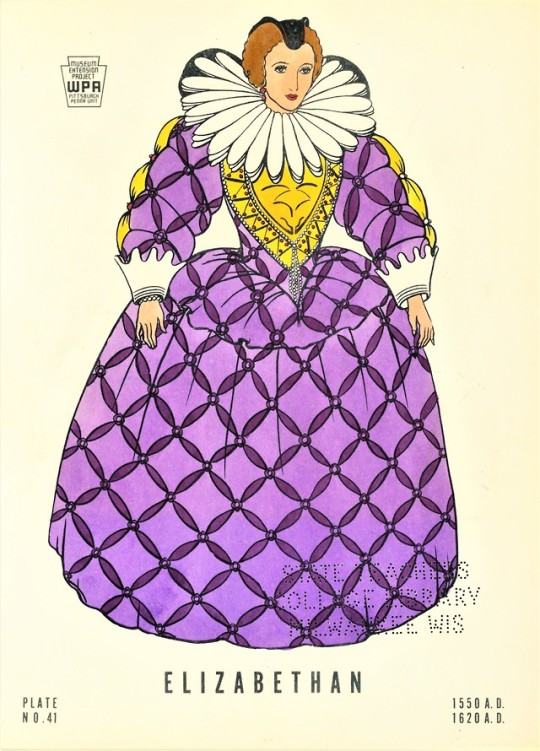
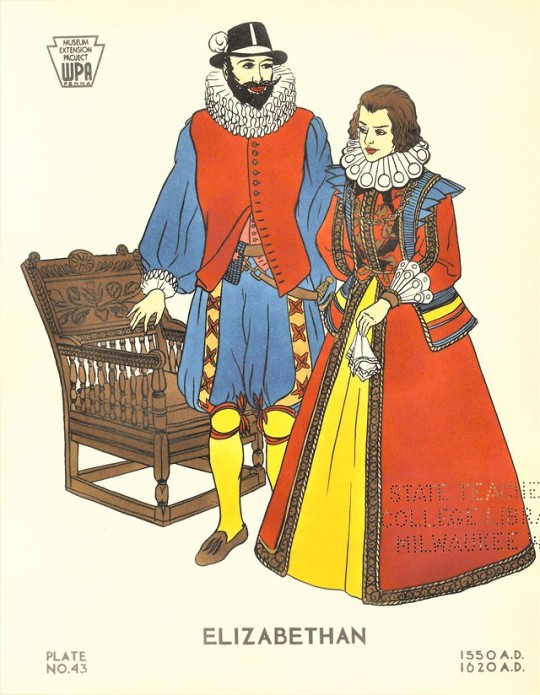
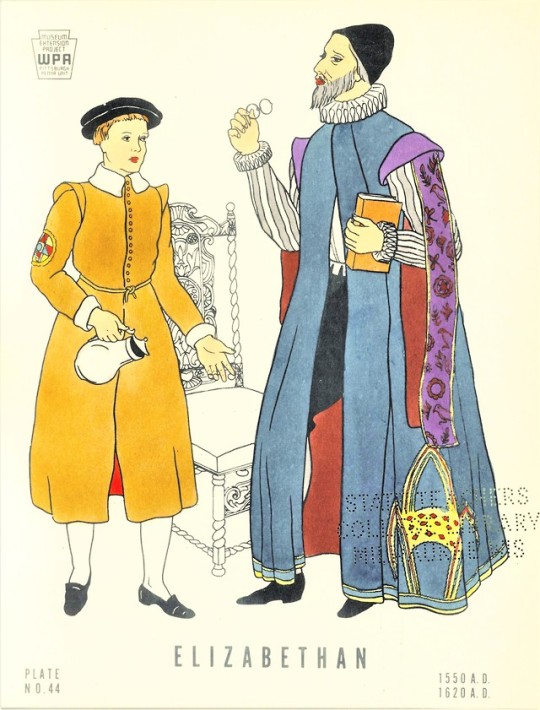
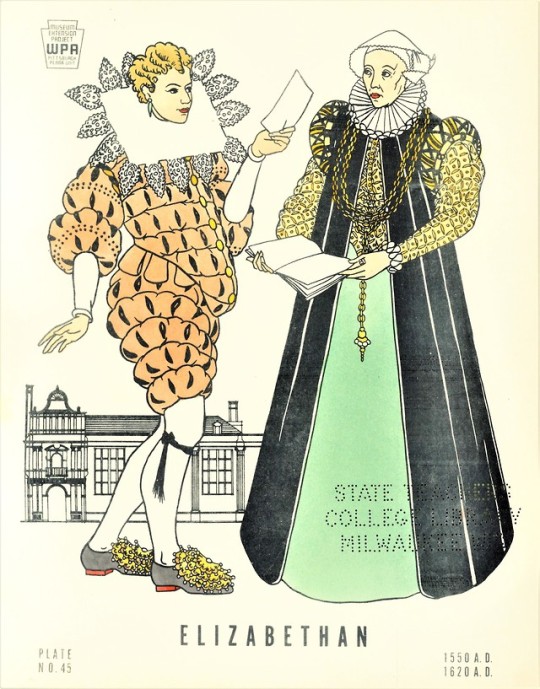
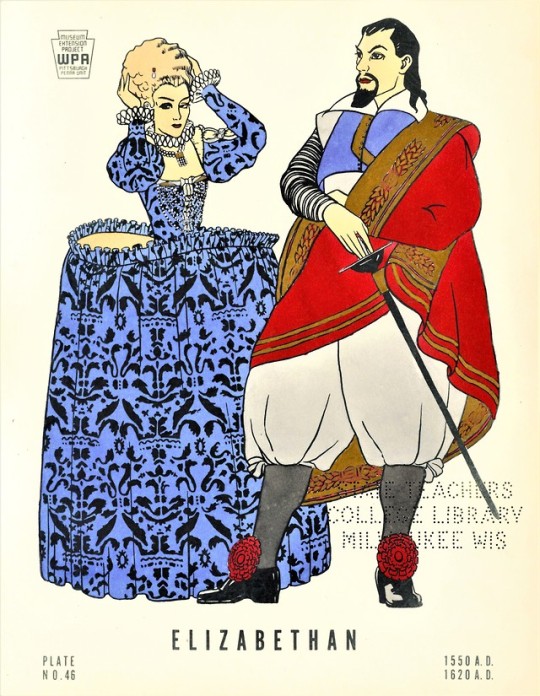
Fashion Friday — Costumes of the World
Elizabethan England, aka “Bess-Dressed to Impress”
Today, we continue our fashion tour of history with a look around the Elizabethan period, roughly 1550-1620. We present a number of hand-painted fashion plates (plate nos. 38, 40, 41, and 43-46) from Costumes of the World.
Yards of damasque and ruffs galore. Plus, a wheel farthingale of preposterous proportions (see plate no. 46)! There’s so much to comment on in these fashion plates that we could not do it justice in one post. Instead, we direct those interested in Elizabethan fashions and the historical context to this great essay, Clothing in Elizabethan England, written by Liza Picard for the British Library.
We hope you enjoy these fashion plates as much as we have.
**If you’d like to learn more about the Museum Extension Project and how items like this book were created and used in service of communities and education efforts by the Works Progress Administration be sure to read the first post in this series. Or, try perusing the rest of our Fashion Friday series.
– Katie, Special Collection Graduate Intern
#Fashion Friday#fashions of the world#historic fashions#elizabethan fashions#16th century fashions#Costumes of the World#Works Progress Administration#Pennsylvania's Museum Extension Project#hand colored plates#Katie
30 notes
·
View notes
Text
So uhhh my headcanons on feminine clothing in the “main four” Westerosi regions in my mind, ie the four regions that are right next to each other with the majority of influence in the Seven Kingdoms and the most similar cultures. The Riverlands, Westerlands, Stormlands, and Reach. In my head they all wear various forms of clothing from roughly the late middle ages, with specific styles for each region


The Westerlands are a pretty basic Tudor shape. They’re all about ostentatious displays of wealth in every possible way, rich fabrics, rich jewels, time consuming constructions, etc. The flaunting of wealth extends even to things like wider sleeves that use up more fabric. In general, the idea is not just to show off, but also to sort of stand out against the landscape. With lots of flatlands, Westerland women prefer deeper, richer colors and textures. Plus it means not very much floral or nature motifs in fashion.


The Riverlands are similar to the Westerlands in silhouette as they are right next to each other, but are much more subdued when it comes to extravagant jewels. They’re a more down to earth culture, so narrower sleeves and modest necklines, more gloves and hats as you get further north. That being said, as they are practical people impracticality is their version of wealth flaunting - ie, clothing that is time consuming to make, costs a lot of fabric and material, and/or is difficult to wear and move in. Ruffs, even small ones, are a staple amongst all nobility. For their highest born ladies, especially on special occasions they’ll break out the French farthingale. And of course, the whackiest of shapes for headgear.
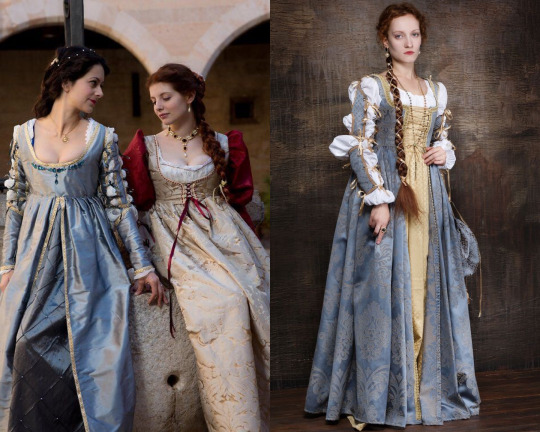

I envision that as you get further south in Westeros the clothing becomes less structured. The Reach is the epitome of the romanticized medieval period, where they believe in true knights and chivalry. Their clothes are all designed with a romantic aim in mind. The silhouette allows for a flattering structure no matter your body type, and the skirts get to flow freely around you. The Reach style is the epitome of fashion in Westeros, and it’s influences are being seen all over - even Cersei Lannister as queen occasionally veers away from her staunch loyalty to her homeland’s styles for the sake of staying fashionable and attractive. The Reach is a massive chunk of Westeros, so the border parts of the reach do bear similarities with styles from other regions. Go north and you’ll see some Westerlands decor elements on Reach silhouettes, go towards the Stormlands and the fabrics get thicker and more durable, more similar to houppelandes.

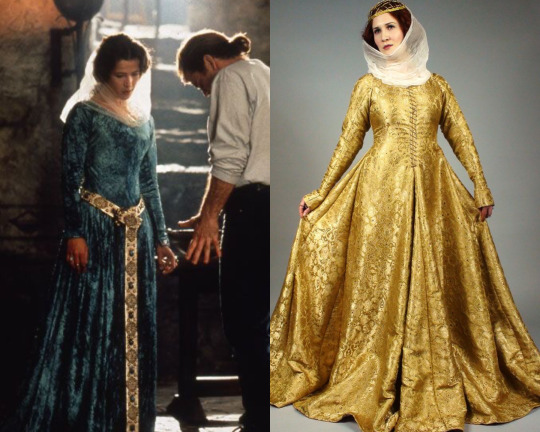
The Stormlands have been wearing the same styles for years and years, as they have less care for frivolities like fashion (so they say - they still very much like to dress wealthy). That’s only recently started to change, what with a Baratheon on the throne bringing an eye to their region for more than just their port trade. Less dress structure in the south, and a cage skirt like a farthingale is incredibly impractical in stormy weather. Instead, it’s a lot of layers of very heavy fabrics. Richer women show off with more and more expensive damasks and velvets, along with more fabric. Using more fabric than is necessary is the ultimate showing of wealth, and skirts being so long and heavy that the noblewomen have to actually carry them shows how little they have to work for that wealth. I think amongst younger people, Reach styles are starting to have an influence as they are right beside the Stormlands. Burgundian gowns have become all the rage, especially as you can add fur linings to it (both useful and showy in the windy Stormlands). In general more defined and higher waists are becoming much more commonly seen, especially once Renly married Margaery and his supporters in the Stormlands start to emulate her.
26 notes
·
View notes
Text
Fanfic Au (calling it classic fantasy au) where Bruno is a dragon and Griselda becomes a knight that decided to go slay him, but she ends up failing in love with him. (decided to put my own spin on it) Part one.
The royal court gathered in the court of the Crimson Castle. Even the lowly servants, the knights and the jester were gathered to hear what the Chief Advisers to the King Cioccolatta, Secco, Tiziano and Squalo. The royal advisers stood in front of the court and gazed down at them. Tiziano cleared his throat.
“The royal court of the Crimson King, Princess Trish was travelling to see the King for a ceremony yesterday, but we have some terrible news, but we have some bad news…” Tiziano announced before being cut off by Cioccolata. “The dragon has kidnapped Princess Trish! I repeat the dragon has kidnapped Princess Trish!” hollered Cioccolatta to the court as they were sent in a frenzy of hysteria. The-Lady-in-Waiting Griselda Streusel tried to remain calm, but she struggled not to burst into hysteria along with the court.
“Settle down! Settle Down!” Sqaulo ordered. “I gathered these three monster men that will do our work for us instead of using our precious knights so settle down!”. The court calmed down when he said that the three monsters would come in to rescue the princess. “How could we even trust the monsters? What if they take the princess for themselves?” One servant muttered.
“If you have any concerns don’t worry, they sighed a contract to slay the dragon and bring back the princess, if they disobey the contract they will be tracked down and sentenced to death,” Sqaulo reassured the court. He turned his head to the door. “You three monsters may come into this court but take great care to not damage the room and don’t gaze at the court,” Cioccolatta ordered as the three monsters came in.
The three monsters came in. The first one was a centaur with a huge dark horse body and a long tail. His name was Mista and his hooves clopped across the group as he walked in. The second one was a feathered harpy with brilliant blond feathers, known as Fugo, he flew in and landed on the front of the court. Finally, a young and youthful elf boy named Narancia walked in the court.
They all wore dark brown tunics that resembled rags and they kept their head down to avoid looking at the court. They didn’t dare to look up. The entire court looked disgusted to see the three monsters and they turned their gaze on them. Griselda gazed at them as deep down she wasn’t disgusted with the monsters. “These are the three men that will complete our objective and now leave,” Sqaulo explained to them and he made some shooing motions to the three monsters to leave the hall. They left the court quickly.
The court was dismissed from the hall. Griselda left and she was making her way to the quarters. Squalo was discussing with the three monsters about their contract and he noticed her. He beckoned her to come which she walked slowly towards them. “What do you mean Chief Adviser Sqaulo?” she inquired him. “Lady Griselda, since you are princess Trish’s companion, could you please describe exactly what she resembles since a painting won’t be enough for their simple minds,” Sqaulo requested.
“I will complete the task; I will take them to my quarters, and I will dismiss them myself Chief Adviser Sqaulo,” she responded. “But these are monsters, they can’t go into your quarters from a lady like yourself!” Sqaulo protested. Griselda responded with a firm and harsh look as she walked past him leading the monsters to the quarters.
Griselda took them to her quarters, she led them to her study, and she gestured for them to sit on three stools in front of her, she was being a little ignorant on how monsters worked, and she was unaware that Mista couldn’t sit on stools. Narancia and Fugo sat on the stools while Mista just stood there. She was embarrassed as she quickly moved the stool away and gave him a rug to sit on. Mista sat down comfortably on the rug.
They kept their heads down as they dared not to look at her. “You can gaze at me as well as speak to me if you wish, I will treat you with basic respect and dignity,” she spoke up as she wanted to reassure them that her views on monsters were different from the rest of the royal court. They didn’t look up though. She sighed as she knew that they wouldn’t believe that her views on them were any different and they were not going to be easily convinced.
“As you may know, Princess Trish has long and thick bright pink hair, her beautiful hair is tied in long braids with strands of white ribbons, her dress is dark red with fine pearls on it with a crimson brooch shaped like a devil representing our kingdom Passione,” she described to them, she pointed at her brooch shaped like a white devil to show what the brooch looked like. She carefully described Trish to them but taking great care to not speak to them like they were obtuse. They nodded silently. She wanted to find a way to speak to them and she decided to ask them some questions.
“So how were you recruited by Chief Adviser Sqaulo?” she asked them. “The Chief Adviser went to our village and told us about the kidnapped princess, promising riches if we completed it, we decided to do it,” Fugo seemed to mutter. “But aren’t you afraid of the dragon?” she asked them. “We will do anything for money lady,” Mista mumbled. “Do you have anything to defend yourself against the dragon?” she asked them as she knew the dragon was a powerful creature. “We have farming equipment,” Narancia piped up.
Griselda was shocked that they had nothing to defend themselves against the dragon. “That won’t do, here have 1000 crowns to buy yourself some weapons, armour and some food for your travels,” she offered kindly as she walked to her treasure chest and she opened it. She took out a beige silk bag and filled it with coins. She handed it to Mista. “Make sure to hide it well,” she advised them as she knew that everyone in the castle would assume, they stole the money. Mista nodded as he hid it in his tunic.
“We need to go, Lady,” Fugo spoke up as he nodded at Mista and Narancia as they got up. “Before you go, my name is Griselda, what are your names?” she asked them as she led them down the halls to the portcullis (sliding door) of the castle as it opened. “Well my name is Fugo,” harpy Fugo responded. “This is Mista,” he said pointing at centaur Mista. “And this is Narancia,” he finally finished pointing at elf Narancia. “Thank you Fugo, Mista and Narancia, I wish you great luck on your quest and please, please, please bring back Trish,” she told as she looked at them seriously because she desperately wanted Trish to come back. The three monsters nodded as the draw bridge by the moat was down and they left the castle.
Griselda waited days and days for them to return with the princess. She paced around her bedchamber wondering when those three monsters were going to come back and she fiddled with her hands anxiously. She kept wondering if the three monsters were killed by the dragon and she blamed herself for not providing them with at least a small team of knights to protect them.
She even wondered if they abandoned the mission and she ended up taking out her frustrations on her embroidery by destroying it. She ripped it apart and she stomped on the ripped rags as she imagined them to be the three monsters’ bodies. She eventually calmed herself down and sat on her bed. She started to think about Trish and how much she missed her as her companion. Her own mother became the-lady-in-waiting of Trish and she knew her as she was just a few years older than her. They both become close friends and eventually Griselda would become her lady in waiting after her mother retired.
She started to long for her so much that she couldn’t bear it. She was going to rescue Trish herself. She left her bedchambers, she went down to the great hall where the map to the Dragon’s Den was located and she took it. Then she went down to the storeroom where all of the knights’ armour and weapons were stored. She removed her fine dress taking off her kirtle (part of the petticoat), farthingale, detached her sleeves and stays (an early version of the corset) until she was just in her white smock and stockings. She removed her partlet, ruff, her jewellery and she let her long blond curls down.
She put on the suit of armour, but she decided to leave the helmet out. She walked out into the castle grounds, she pulled a chain that would open the portcullis and the drawbridge. She went down to the stables of the castle, she went to her horse named Joan, climbed on the horse and she galloped out of the castle grounds to rescue Trish from the evil clutches of the dragon.
#JoJo's Bizarre Adventure#jojo golden wind#jojo vento aureo#bruno buccerati#griselda#jojo part 5 oc#fantasy fic#fantasy au
2 notes
·
View notes
Note
Cider is wonderful—I haven’t had many different types of alcohol, but cider is my definite go-to, especially when it takes me back to when I first drank it (and alcohol) at a renaissance faire. Ah, happy times
Ren Fairs are the devil’s own deceit, I tell you. I find them tasteless at worst and anacronistic in an annoying way at best. The turkey legs are good, mind you, but we didn’t fucking have turkeys did we? No. We did not. We didn’t have citrus. Or tomatoes. Potatoes. Corn. None of that. Bison burgers? What the hell is a Bison? Scottish highland cows? Now there’s a meal. Legs of mutton, a feast? Someone butcher that fat bastard of a peacock roaming the place unchecked like a belligerent Spanish diplomat (so actually just a Spanish diplomat, I suppose) and we might have something akin to the times. Bosoms out, here here, but sleeves are not attached you fashionless nimrods. Farthingales! Sideslung Spanish cloaks. Ruffs so floppy you look like your heads are on lacy platters. Hose! You savage fiends. And the men should be wearing heels!
Also, you all smell entirely not right. It’s indecent.
A true fair in the Renaissance was like a swap meet. People at tables all shouting. Meat hanging from things. May poles and dances. archery, axes and weak beer. Wine with water. Spices everywhere. Animals being sold and butchered. CHEESE! Oh the cheese! It was loud and crowded. Mud and dung and piss everywhere. There were men who sold cartographic directions. There were people who’d analyze your urine. Apothecaries with all manner of stupid thing mostly made of bile and grease. Crowds of old men huddling around in various states of falling over, propped together, but about to collapse in like an old herdsman shack in a windstorm. Fortified by liquid strength, they were, many missing limbs and eyes.
That’s a fair. These days the Ren Fairs are entirely too sterile.
18 notes
·
View notes
Text
Women’s Fashion Over Time
In its vast timeline, the history of fashion in art reveals a complex socio-economic system influenced by a culture of valuing individual collectives in a world of dynamic change. It is a unique system in that which its influences are found in close quarters; a grapevine of cultural impact showing people influencing people. The ensembles worn by subjects in various paintings and sculptures present us with a glimpse into the socio-economic conditions under which fashion became a commodification of social status and a symbol of societal and cultural value. As cultural events and new political climates rise, causing shifts in values and general rules of fashionable appearance tastes in fashion appears to change. Yet the relatively stable constant in notions towards fashion is a prescribed label of class, and therefore, your worth and position in society, associated with the clothing you wore. In a series of six costumes inspired by the Early Renaissance, the High Renaissance, the High Renaissance in Europe, Baroque art, Rococo to Neoclassicism, and Romanticism, I will break down the fashion trends of each period, focusing on iconic features of each fashion period and briefly explaining the cultural context of each garment.
The Early Renaissance


This costume is based on the ensemble worn by Giovanni Arnolfini’s wife in the painting Giovanni Arnolfini and His Wife by early Renaissance painter Jan Van Eyck. A popular staple piece in early Renaissance fashion was the houppelande which was carried over from the fashion of the middle ages. In The Concise History of Costume and Fashion by James Laver, he describes the general appearance of the houppelande as a garment that fitted the shoulders and was loose below, with a belt at the waist; the houppelande is what will later be known as ‘gown’.[2] This replication of a typical houppelande has a high collar and extremely long sleeves, fur trimming and fur lining, and hanging tippets from the edge of the sleeve to the back of the gown. The gown itself is extremely long, ballooning outward from the waist. The houppelande could be made in a selection of fabrics such as wool, silk, and velvet[3], and were could be dyed a rich, vibrant colour as seen in Jan Van Eyck’s painting. Since the middle ages, the use of fur in fashion had become symbolic of wealth and importance and was oft worn by nobility.[4] Since fur was difficult to come by, it was an elitist luxury used in excess by middle and higher class people, establishing a social distinction between them and the lower-class through their clothing. As for the headdress, at this point, not much has changed since the middle ages in terms of style. However, the custom of covering mature and married women’s hair was becoming less strict, and we see more women revealing their hairstyle beneath their headdress.[5]
The High Renaissance


This High renaissance costume is based on the Mona Lisa by Leonardo da Vinci. The During the High renaissance, many cultural trends such as the rise and spread of books, the expansion of trade and exploration, and the increase in power and wealth of national monarchies in France, England, and Spain influenced tastes in fashion and the dynamic changes fashion underwent, as well as the idea of the modern ‘trendsetter’.[6] The essential garment for the High Renaissance woman was the gown. Its general features were the bodice, a skirt, and sleeves. The complex ensemble of the gown during this period can be seen in da Vinci’s Mona Lisa. The gown could be made from luxurious materials such as silk, velvet, and lace, worn with lavish jewelry, and decorated with intricate patterns of stitching and embroidery.[7] While the gown silhouette was common across social classes, the distinction lies within the materials used. Although the wealthy and powerful used expensive textiles for their gowns, the lower-class was still capable of emulating the gown with the materials they had access to such as wool and cotton.
The High Renaissance in Northern Europe
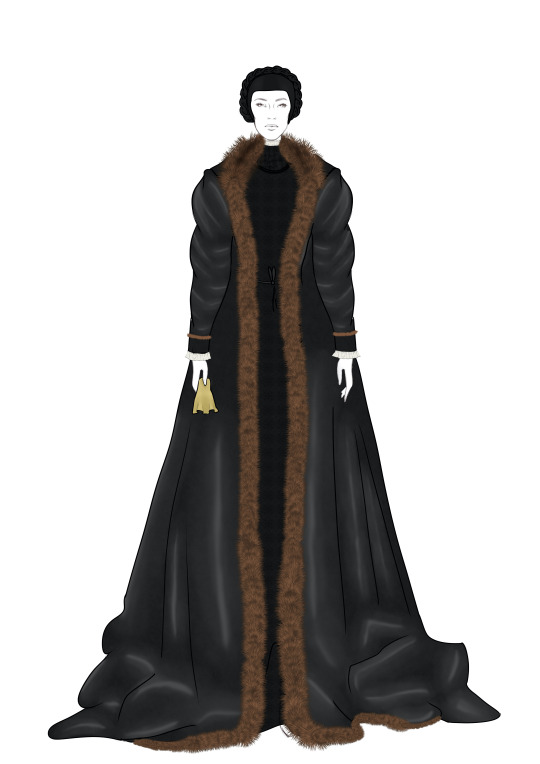

My iteration of Northern European High Renaissance fashion is based on Hans Holbein the Younger’s Portrait of Christina of Denmark. This portrait demonstrates the conservative side of fashion that was flourishing alongside a bold, vibrant movement that was challenging established trends. The model adorns a dark, velvet gown with a high collar; underneath we see a glimpse of the ruffs from her high collared undershirt. The ruffs were a common feature of the late fifteenth and sixteenth centuries, typically characterized as an upright, stiff collar that ruffles around the neck; ruffs were commonly adorned by noblemen and noblewomen.[8] Now, Holbein’s Portrait of Christina of Denmark does not show the typical extravagant ruffled collar, which could have been a stylistic choice by Holbein to allow the fur lining and trim of the subject’s outer gown to stand out, and remain the statement feature representing her wealth in the painting. The large size of the outer gown appears to further imply how much fur the gown is made of.
Baroque Art


The Baroque artwork I’ve based this costume design on is Vermeer’s, Girl with a Pearl Earring. The Baroque period introduced innovations to the popular sixteenth-century gown. At the time Vermeer’s Girl with a Pearl Earring was composed, seventeenth-century fashion had already gone through several evolutions. Stomachers, which was either a v-shape or u-shape panel meant for decoration and structure, had become stiffer and flatter and elongated past the line of the waist.[9] Replacing the trend of using wired hoops, or farthingales, to give body to the skirt was the petticoat. The petticoat was a practical solution to the everyday issues of functionality women faced with farthingales. Petticoats made of cotton or wool were perfect for warmth, while more fashionable petticoats were made of taffeta, satin, linen, or a combination of starched fabrics.[10]
Rococo and Neoclassicism
This costume was inspired by Vigee Le Brun and her artistic style which can be described as being a mix of rococo colours with elements of the Neoclassic style. As a prolific French portrait painter, one of her prominent subjects for portraits was Marie Antoinette, the Queen of France who despite her tumultuous life in the public eye, was a fashion icon. The genius in Le Brun’s craft lies in her vast knowledge of current fashion and her awareness of the power of appearance.


I based this costume on Vigee Le Brun’s, Self Portrait in a Straw Hat. In the painting, Le Brun is wearing a variation of the robe en chemise which emerged during the late eighteenth-century period as tastes in fashion moved away from the early period’s penchant for fuller-bodied skirts.[11] While its design echoes elements of early Rococo style, the robe en chemise was a gown made simple. These dresses were usually made of sheer, white cotton, with high waists and wrapped with a decorative satin sash; its slender silhouette was inspired by the fashion of ancient Greece and ancient Rome.[12] These dresses could also come in various colours, such as the rose-gold coloured dress Le Brun is wearing in her self-portrait. With its sheer material and low-cut neckline, the robe en chemise gained widespread attention because of its revealing nature; until this point, the gowns we’ve seen have been voluminous and covered much of the female body. Yet, this scandalous fashion found its way into the wardrobe of royalty, and most likely, the wardrobe of some upper-class women who wanted to be revered for wearing the latest fashion. This portrait of Marie Antoinette wearing a robe en chemise was painted by Le Brun.
Romanticism
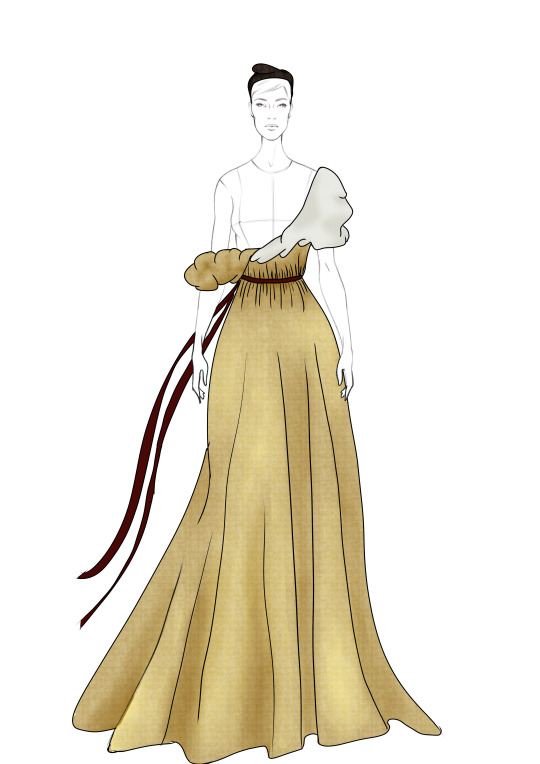

Based on Delacroix’s, Liberty Leading the People, this costume is an iteration of the symbolic fashion of the woman in his painting. She is Liberty; she represents freedom, in an image that evokes a triumphant revolution as she leads people on the battlefield. The Romantic movement differed vastly from the current situation in early nineteenth-century France, which was characterized by social unrest and civil war between the bourgeoisie and the working class.[13] Romanticism was mostly a reaction to the modern realities brought on by the industrial revolution; the romantic movement in art reveals a desire to escape these modern realities, a theme which Delacroix’s painting emulates perfectly.
Liberty Leading the People encapsulates the transitional period between Neoclassicism and Romantic sensibilities.[14] There are neoclassical elements in Liberty’s appearance, but most prominent is her dress. The painting feels reminiscent of the time of unrest during the French Revolution, which Liberty embodies in her wearing a robe en chemise, referred to simply at this point as ‘a dress’. In general, dresses of any kind were lighter and much sheerer than garments from the eighteenth-century but the general features of the dress were kept the same: made from any selection of fabrics and usually white or light in colour, short sleeves, high waists and long, straight skirts.[15]
From this brief overview of women’s fashion over time, it is evident that notions towards dress and appearance, and how we tend to associate certain styles of fashion to specific groups of people and/or cultures have not changed. Although fashion continues to evolve, the same old fashion trends appear and disappear, then reappear; reinvented or inspiring a consequent fashion movement. There is a romantic sensibility in the way we often tend to return to past fashion trends. It begs the question if there will ever be a completely fresh fashion movement, or will our futile attempts remain the shells of historic innovations in fashion from the past. Nevertheless, as one of few primary resources for contemporary fashion designers, these artworks reveal the true impact of fashion and art as they continue to influence fashion and social cultures in our modern world.
––––––––––––
Footnotes
[1] Ibid. 600.
[2] Laver, "The Concise History of Costume and Fashion: Laver, James, 1899-1975: Free Download, Borrow, and Streaming." Internet Archive. January 01, 1969. Accessed July 17, 2020. https://archive.org/details/concisehistoryof00lave/mode/2up, 64.
[3] Pendergast, Sara, Tom Pendergast, and Sarah Hermsen. Fashion, Costume and Culture: Clothing, Headwear, Body Decorations, and Footwear through the Ages. Vol. 3. Detroit: U.X.L, 2004, 450.
[4] Ibid. 624.
[5] Ibid. 488.
[6] Ibid. 469.
[7] Ibid. 477.
[8] Ibid. 482-483.
[9] Ibid. 521; 525.
[10] Ibid. 523.
[11] Ibid. 570.
[12] Ibid. 570
[13] Hurley, Clare. "French Romantic Painter Eugène Delacroix at the Metropolitan Museum in New York." French Romantic Painter Eugène Delacroix at the Metropolitan Museum in New York. December 20, 2018. Accessed July 22, 2020. https://www.wsws.org/en/articles/2018/12/20/dela-d20.html.
[14] Ibid.
[15] Pendergast, Sara, Tom Pendergast, and Sarah Hermsen. Fashion, Costume and Culture: Clothing, Headwear, Body Decorations, and Footwear through the Ages. Vol. 3. Detroit: U.X.L, 2004, 622.
–––––––––––
Bibliography
Hurley, Clare. "French Romantic Painter Eugène Delacroix at the Metropolitan Museum in New York." French Romantic Painter Eugène Delacroix at the Metropolitan Museum in New York. December 20, 2018. Accessed July 22, 2020. https://www.wsws.org/en/articles/2018/12/20/dela-d20.html.
Laver, James. "The Concise History of Costume and Fashion: Laver, James, 1899-1975: Free Download, Borrow, and Streaming." Internet Archive. January 01, 1969. Accessed July 22, 2020. https://archive.org/details/concisehistoryof00lave/mode/2up.
Pendergast, Sara, Tom Pendergast, and Sarah Hermsen. Fashion, Costume and Culture: Clothing, Headwear, Body Decorations, and Footwear through the Ages. Vol. 3. Detroit: U.X.L, 2004.
0 notes
Text
Okay here's my review!
Undergarments: I like that they knew the term smock because that is what the garment was called at the time but like. They didn't wear it under every different outfit. They also didn't mention that men wore a very similar garment and that was their underwear for the whole body. They do know about bum rolls and farthingales and the shape is acceptable for italian women. I really don't like that they called the pair of bodies a corset!! Pairs of bodies are VERY different than corsets. They are heavily boned and current evidence suggests only the VERY upper classes wore them. Corsets are much more lightly boned and were worn by all classes of women! A lower class woman would've worn a kirtle or bodied petticoat which is a skirt with an attached bodice stiffened with layers of fabric. The petticoats were. Bad.
Upper class women: They're being anachronistic with colors and patterns I'm assuming which is fine! Whatever Zach is wearing is really disappointing. I think I get the style of sleeve they're going for but it should really have a shoulder roll and not just be gathered at the top. I've only seen bodices like that on italian images of women from the time when they're laced in front and don't have any sort of stomacher so there should really be front ladder lacing. Eugene looks better but the pattern is a bit weird and I don't know why his ruff is black? But that could be an artistic choice. Keith looks really weird. Ignoring the color and pattern because y'know artistic choices I don't really know what that ruffle on the bodice is for and the bodice itself looks pretty ill fitting. The sleeves aren't great either. They have the ruffle at the cuff which is good but again no shoulder roll! The neckline is alright but you don't tend to see that style of ruff with that sort of neckline. Also while Juliet is a child, she still should be wearing her hair up as even very young girls tended to do
Working class woman: I'm not familiar with clothing worn by medical workers so no comments there but uh. Working class people didn't really follow the trends of the upper class that much. They were VERY far removed from each other apart from servants and sumptuary laws prevented even wealthy merchants to wear things the rich did. It was also looked down upon to try and dress above your station. Keith and Zach did not wear smocks under their clothes which is really disappointing because they noted earlier in the video that all classes wore smocks. They were INTEGRAL in keeping your outer clothes clean which was a necessity. Keith doesn't look the worst but working class people wore lots of colors! Also I think the bodice is cross laced which wasn't really a thing. Spiral lacing or ladder lacing would've been used instead. I'm not really sure what the green gown Zach has is and I've never really seen something like it but it could've existed
Upper class men: I've definitely seen worse. I wish they would've included the peascod belly because it's something really unique to this era and it's very interesting! I also think it would've been fun if they played around more with colors on the stockings because they weren't only white! I'm not quite sure what the black studded v Keith has is and his ruff is a little sad. Zach's breeches are a little too long but that could just be because they weren't made for him
None of this is to say the guys did anything wrong! It's just observations of the discrepancies between what they wore and surviving evidence I've been able to get my grubby hands on in the past two ish years
0 notes